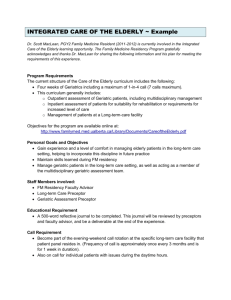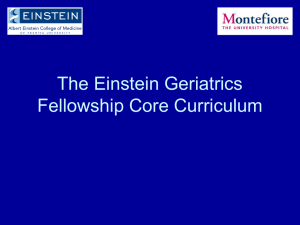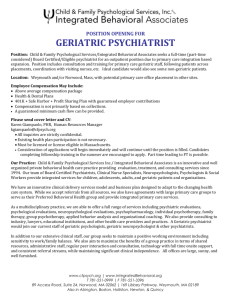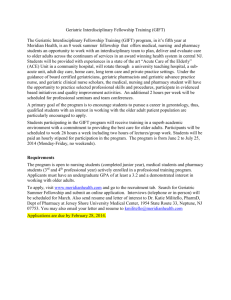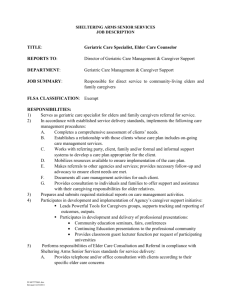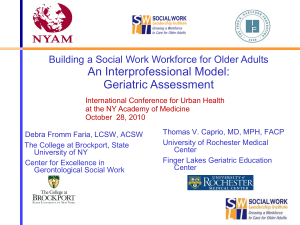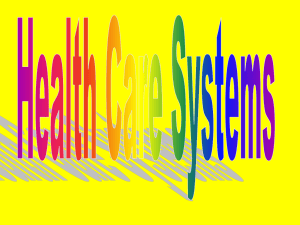the comprehensive assessment of an older person - E
advertisement
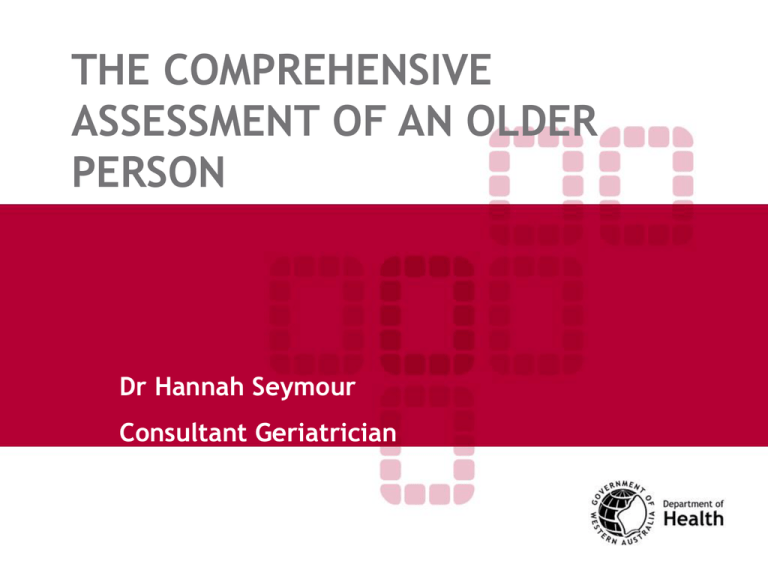
THE COMPREHENSIVE ASSESSMENT OF AN OLDER PERSON Dr Hannah Seymour Consultant Geriatrician • Thanks to Mark Donaldson for the use of his slides.. The Comprehensive Assessment of an Older Person • Domains of Assessment • Sources of collateral information • Use of professional interview style • Timeliness and consistency • Interdisciplinary • Use of Validated assessment tools • Questions The Comprehensive Assessment of an Older Person The Population is Ageing • Fastest growing segment is old old i.e. >85 years.(? Maybe not true in Kimberley) • Highest rates of chronic diseases and physical disabilities. • Highest rates of hospitalisation and institutionalisation. • There are benefits to the patient, care givers, especially family, and the health system by providing an expert clinical evaluation What makes an Assessment • is a multidimensional process, which should include an evaluation of client’s needs in areas of: • restorative, physical, medical, • psychological, cultural and social. • multidisciplinary. • Independent process Client Focused Assessment: • privacy and confidentiality; • information; • consent; • a carer/advocate; • participate in decision-making; • a copy of the assessment/outcomes; • complaint and appeal information. • Explain reason for assessment / intro. The Comprehensive Assessment of an Older Person Domains of Assessment • Physical • Mental • Social • Environmental • Functional - physical mental social activities of daily life The Comprehensive Assessment of an Older Person In the older patient with chronic, progressive and usually incurable disease, functional status becomes an increasingly important indicator of quality of life. Thus, preventing functional decline has highest priority and drives the process of diagnostic and clinical decision-making. The Comprehensive Assessment of an Older Person Benefits of Comprehensive Geriatric Assessment Depends upon setting but, overall: • Improved diagnostic attainment • Increased use of home health services • Reduced medical care costs • Reduced length of hospital stay • Reduced or delayed admission to institutional care • Improved functional status : fewer medications : improved cognition • Reduced readmission rates • Increased survival (less often) The Comprehensive Assessment of an Older Person Aims and Framework of Assessment • Improve, maintain or reduce rate of functional decline. • Aim to improve or maintain independence and autonomy. • Multidisciplinary assessment to harness specialty skills in key areas. • Translation of assessment to action plans to add value to care, is critical. The Comprehensive Assessment of an Older Person Functional recovery facilitators: • Medical optimisation • Home set-up and services • Rehabilitation – Home based therapy - Day Hospital therapy - In-patient The Comprehensive Assessment of an Older Person • Communication internally by inter-disciplinary team is vital. • Patient and carer education and outcome communication is vital: verbal, written or both. • Translation of assessment includes ensuring connection with specified services (i.e. prescription and dispensing) • Partnership between the patient, family, home care providers and health, especially the G.P., is critical. The Comprehensive Assessment of an Older Person Sources of Collateral Information: • Introduction to patient • Consent for interview, focus on the patient initially • Not performance theatre, recognise privacy • Extended to involve most important others as appropriate • Avoid pre-interview sessions where possible The Comprehensive Assessment of an Older Person Timeliness and Consistency: • The hallmark of the Geriatric syndrome is where an older person is predisposed to an adverse event that only requires a precipitant to occur e.g. Falls and injury New incontinence Delirium Reduced mobility Iatrogenic events • A small improvement across a large population can make a big difference by altering thresholds e.g. Falls Carer stress Institutional risk The Comprehensive Assessment of an Older Person Timeliness and Consistency: The triage process must be robust as it will select a response along the axes of: • Health care worker selection • Prioritisation The Comprehensive Assessment of an Older Person What are the clues for increasing urgency? • Age – extreme • Lives alone • Source of referral • Urgency annotation • New features of illness • Polypharmacy • Recent functional decline • Worsening confusion (i.e. delirium) There is clearly a potential conflict between urgency of response, maintenance of a multi-disciplinary approach and occupational safety and health issues. The Comprehensive Assessment of an Older Person Medically-orientated Assessment • The Geriatric Assessment is performed in addition to standard medical history and physical examination. • The assessment seeks to uncover common conditions of frailty that affect functional status, e.g. - Impaired vision - Impaired hearing - Reduced mobility and falls - Geriatric syndromes - Cognition - Depression - Malnutrition - Urinary incontinence - Falls - Iatrogenic illness The Comprehensive Assessment of an Older Person INTERDISCIPLINARY • The comprehensive assessment can be done by a generic elderly health care worker, a General Practitioner, medical specialist or through a multidisciplinary approach. • It can be extended over time and place. • The tools of assessment are the structured interview utilising screening instruments for: Cognitive Affective Functional Social (context and consequences) Economic status • Assessment especially useful for : People in transition Recent onset of physical or cognitive impairment Fragmented (medical) care Care-giver strain.

